Jet torpedo RAT-52
History The PAT-52 project dates back to the mid forties. In February, 1946 was founded by the Research Institute-2 (now FGUP GosNIIAS) of the Ministry of Aviation Industry, and in July, a group of employees from the Research Institute-1 headed by Grigory Yakovlevich Dillon was transferred to this organization. Previously, these specialists were engaged in the improvement of aviation torpedoes, created on the basis of existing structures. At the new place of work, the designers had to create a completely new torpedo for naval aviation. Since the development of torpedoes for airplanes was not part of the tasks of the Scientific Research Institute-1, this project was entrusted to the “Aviation” Scientific Research Institute-2, and for the effective implementation of the work there were transferred employees with the necessary experience.
Then, in the 1946 year, G.Ya. Dillon, having carefully studied the existing weapons and their prospects, prepared a work that justified the need to develop a torpedo, originally intended for the use of naval aviation. In this case, it was possible to immediately calculate the parameters of the design of the torpedo in accordance with the intended method of application and thereby ensure the most effective conduct of the attack. The implementation of such ideas was entrusted to SRI-2 and its new employees.
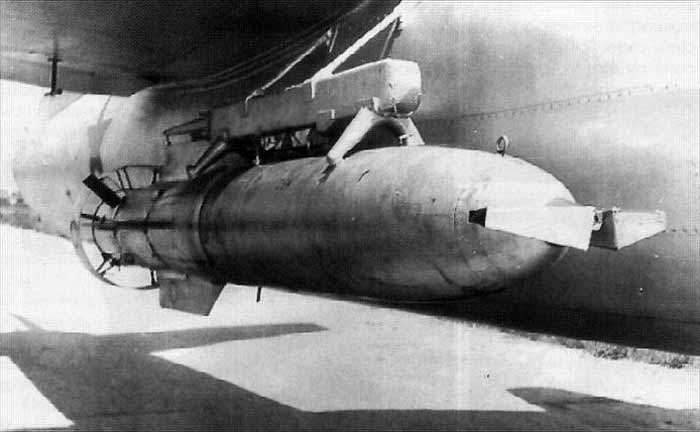
Torpedo PAT-52 under the center of the IL-28T. Well visible wing for output to a predetermined depth. Photo Militaryrussia.ru
Even before the transfer to the Scientific Research Institute-2 G.Ya. Dillon and his colleagues managed to form the overall look of a promising weapon. It was proposed to create a relatively light torpedo caliber 45 cm, carrying the maximum possible explosive charge. In addition, at a certain stage, it was proposed to abandon the existing power plants with screw propellers and use a powder jet engine. The use of such a power plant made it possible to reduce the size and weight of the torpedo, as well as to a certain extent simplify its design. In addition, a significant increase in stroke performance was expected.
The new project NII-2 received the symbols A-2 and D-44. Full-fledged work on the creation of these weapons started in 1947 year. Due to the proposal regarding the use of finished components, the development of the project took only a few months. Already by the end of 47, an experimental batch of new torpedoes was manufactured and tested. The production of these products was entrusted to plant number XXUMX (now the Moscow Machine-Building Enterprise named after VV Chernyshev). After finishing the design, a new experimental batch of A-500 / D-2 products was released, which were tested in the 44 year. In the future, the role of the manufacturer of experimental weapons was entrusted to the Leningrad plant number XXUMX (now "Red October").
The prospective aviation torpedo was to be used according to the original scheme, which affected its design and the composition of the additional equipment. To improve performance in comparison with existing samples of aircraft torpedoes, the D-44 product should have a number of original features.
In order to reduce the weight of the structure with the corresponding consequences for combat effectiveness, the original light alloy hull architecture was proposed. The body was a cylindrical unit with a diameter of 450 mm with a head fairing and a narrowed tail section. In the tail part of the torpedo there were X-shaped planes with deflected rudders with a span of 750 mm, and on the end there was a stabilizing ring discharged after entering the water. The total length of the product was 3,9 m. The mass of the torpedo was equal to 627 kg, which was noticeably less than the weight of other aircraft torpedoes. In the training version of the D-44 weighed only 500 kg.
The layout of the torpedo was standard for such weapons, but had some features associated with the use of new units. The head of the case was given under the fighting compartment, behind it was a relatively large engine compartment, next to which were control systems and steering machines.
A new type of torpedo received a fighting compartment with a charge of weight 243 kg. To explosive explosives used two contact fuses KAVT-55. These devices should have been triggered by a collision with a target, and two modes of operation were envisaged to destroy the surface and underwater parts of the ship. In addition, as part of the fuses, there were self-liquidators that worked after a certain time had passed. For the training version of the torpedo, a lightweight practical combat compartment with a registrar and a ballast device was proposed. The composition of the latter included a tank for water-alcohol mixture. After hitting a training target or a miss, the automatics, with the help of compressed air, were to displace the mixture, as a result of which the torpedo surfaced.
In the tail section of the torpedo, a solid-fuel rocket engine with a charge of weight 74 kg, borrowed from the PT-45 underwater projectile, was placed. The available fuel charge was enough for 16-19 from work, and thrust from 800 to 1200 kg was created. The exact thrust performance depended on the temperature of the powder charge before the engine was turned on. The nozzle of the engine in the transport position was covered with a drop-off round cap.
The torpedo А-2 / Д-44 was proposed to be dropped from the aircraft, after which it had to sink into the water and begin an independent movement towards the target. For this, the product received an original universal control system. With the help of several gyroscopes, the automatics had to follow the movement of the torpedo and the change of its position in space. In case of deviation from the required course, the command was given to the steering cars. The general principles of control in both environments (air and water) were the same, but their implementation differed.
When a torpedo fell in the air, it had to be stabilized by means of a tail ring, and special steering wheels were used to control the course and roll. After entering the water, it was proposed to use the second set of rudders, which are also controlled by gyroscope-based automation. Also in the water included hydrostat, responsible for maintaining the correct depth. In addition, immediately after entering the water, the torpedo had to use a special discharged wing. The product was delivered with a trapezoidal wing on the head fairing, installed with an angle of attack 23 °. The task of this device was to bring the torpedo to the correct trajectory after entering the water.
In the early stages of the project, it was proposed to equip a torpedo of a new type with a passive acoustic guidance system. Later it turned out that this version of the project would face a number of serious problems. In particular, the homing equipment was too heavy for a new torpedo, and its use was not possible due to the large engine noise. As a result, it was decided to abandon homing and make a torpedo straight.
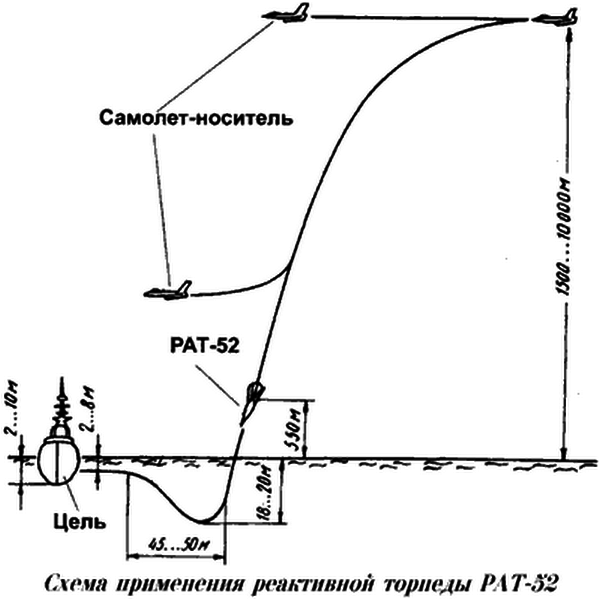
Scheme of the combat work of the torpedo PAT-52. Figure Magspace.ru
In addition to the torpedo, some other equipment should have been part of the advanced aviation armament complex. The main additional system was parachutes, designed for the proper descent of a torpedo into the water and protecting it from hitting the surface and subsequent destruction. The parachute system included a small parachute brake with an area of 0,2 square meters, made in the form of a propeller, and a larger main parachute with an area of 2 square meters, with which it was proposed to deliver the torpedo to the water. Also, the parachute system included the automatic disclosure of the PAS-1 and some other devices.
It was proposed to deliver torpedoes of a new type in special sealed crammed boxes. In order to avoid damage to the solid fuel of the engine, the boxes should be filled with neutral gas, which used nitrogen. Before preparing for use, the torpedo was proposed to be removed from the box and suspended on a carrier plane. Regardless of the type of media, only DER-53T holders were used.
Product A-2 / D-44 was proposed for high-altitude torpedo-metering. This torpedo should have been dropped from heights of at least 1500 m, after which she herself had to descend into the water and attack the target. Before preparing for the dumping, the crew of the aircraft carrier had to enter the depth of the path from 2 to 8 (taking into account the draft of the target, to hit the underwater part) into the automatic torpedoes and charge its capacitors. Next, the combat course was launched, and the torpedo was dropped with the help of an optical bomb sight OPB-6СР. At the right time, the scope automatically gave the command to reset the torpedo.
Immediately after the descent from the holder, the torpedo unfolded a small propeller-like stabilizing parachute. In addition, gyroscopic heading instruments were activated. Their task was to prevent the rotation of the torpedo, as well as its retention on a given vertical plane. At a height of 500-550 m from the surface of the water, the brake parachute was dropped, after which the main chute was opened. With it, the torpedo fell into the water, continuing to adjust its flight.
After entering the water, the D-44 product should have dropped a parachute, a tail stabilizer ring and an engine cover. Entering the water head forward, torpedo performed the so-called. bag, abruptly going to a depth of 20 m and then floating up and forward. For such a movement of the torpedo, a wing on the fairing was used, which was installed at the correct angle: during movement, it created a lifting force and brought the torpedo to a lesser depth. After reaching a predetermined depth, the wing was also dropped.
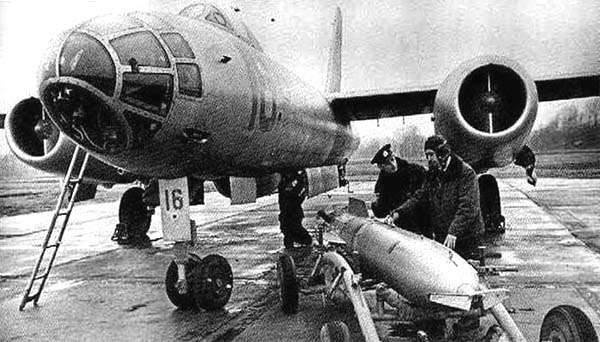
Preparation of IL-28T for combat mission. Photo Airwar.ru
Having taken a horizontal position at a predetermined depth, the torpedo turned on a jet engine. With it, the serial torpedo developed speed up to 58-68 nodes (depending on charge temperature) and covered the distance to 520-600 m. After producing solid fuel, the torpedo could go no more than 60 m, then stopped due to water resistance. At the site of the engine, or shortly after its completion, the torpedo was to collide with the goal and undermine it. In the event of a miss, the torpedo stopped, sank and then was destroyed by the self-liquidator.
An interesting feature of this method of using torpedo weapons was the transience of the attack. When the torpedo was dropped from a height of 2 km, no more than 35 took place before the moment of hitting the target. The first 25-26 with a torpedo remained in the air, and to reach the desired depth and the path to the target took no more than 8-10 with. Thus, even the timely detection of an attack by an adversary did not guarantee an effective countering to it.
The first carrier of a promising torpedo A-2 / D-44 was to be a specially equipped Tu-2T aircraft. In December 1946, Minaviaprom decided to re-equip several such machines for the use of jet torpedoes. Under the center section of the aircraft were mounted holders for torpedoes. In addition, the machines received new sights and equipment for the introduction of commands into automatic weapons. The first launches of experienced torpedoes with similar Tu-2T were performed already in 1949 year. In addition, such carriers were used during state tests.
In 1950-52, the research institute-2 and a number of related organizations conducted several test cycles of new weapons with the use of torpedo bombers Tu-2T. Weapons were reset at speeds up to 450 km / h and at various heights, right up to the ceiling of the car. All the identified shortcomings of the parachute system and other means of launching the torpedo into the water were soon corrected. In the future, this made it possible to significantly expand the list of torpedo carriers.
It should be noted that the first launches of A-2 torpedoes, made in the late forties, ended with the destruction of experimental products. Torpedoes successfully descended into the water, went out onto the combat course and accelerated, and then suddenly jumped out of the water and crashed on its surface. It soon became clear that, due to the relatively high power of the engine, a torpedo in water develops speeds of the order of 100 nodes. When this occurs, the formation of an air cavity, which prevents the torpedo to maintain the correct course. The engine was modified to reduce the speed, but the torpedoes continued to fly out of the water. This time it was necessary to rework control systems.
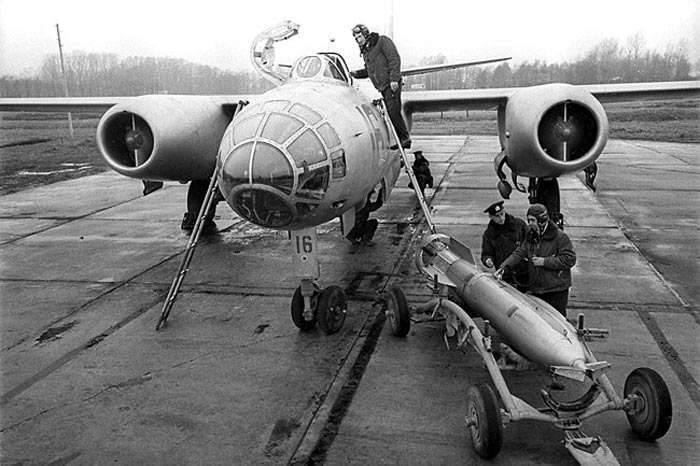
IL-28 and his weapon. Photo Militaryrussia.ru
Factory tests were completed in 1950. After all the modifications, the torpedo of the new model was able to properly sink into the water and get to the target, keeping the course and not flying out of the water. Soon after, state trials began. Discharges from the Tu-2T aircraft at speeds up to 450 km / h were successful and without any problems. In the future, as the carrier of a torpedo, the IL-28T was involved in the tests. At flight speeds up to 960 km / h, new problems with the performance of the parachute system have emerged. The 1951-52 winter was spent by the project developers to refine the parachutes, after which they “learned” how to operate normally over the entire speed range.
By the end of 1952, state tests were completed, which opened up a new path for the troops. According to the test results, the A-2 / D-44 torpedo was recommended for use. The order to put these weapons into service was signed on 4 February 1953 of the year. The torpedo was put into service under the official name PAT-52 (“Jet aerial torpedo sample 1952 of the year”). Serial production of new weapons was entrusted to the plant number XXUMX, which had already participated in the project as a manufacturer of experimental products of the last batches. In the second half of the fifties, production was transferred to the plant "Dagdizel" (Kaspiysk).
The torpedo carriers of the types Il-28T and Tu-14T became carriers of the new torpedo. Tu-2T aircraft by this time were considered obsolete and could not be used in the army, because of which their use in the framework of the new project was limited to a number of tests. In the future, worked out options for the use of carriers of other types.
The first carriers of the product PAT-52 were the IL-28, IL-28T and Tu-14T aircraft. The basic version of the IL-28 bomber could carry only one torpedo in the cargo compartment. The modification with the letter “T” received three holders: one inside the fuselage, two under the wing. Tu-14T received only two underwing holders. In 1956, the jet torpedo was incorporated into the weapons of the Tu-16 bomber. In the cargo compartment of the Tu-16T aircraft there were four holders for PAT-52 fastened.
In the fifties, A.N. Tupolev developed the carrier Tu-91 “Bull-calf”, which was to receive a wide range of weapons for attacking land, surface and underwater targets. Among other things, the possibility of carrying a new jet torpedo was considered. In connection with the abolition of the development and construction of aircraft carriers the aircraft did not go into the series and could not become a torpedo bomber. A project was also proposed to equip the M-4 long-range bomber with six torpedo holders. For various reasons, the project was not implemented.
Shortly after adopting a new torpedo, naval aviation fleet conducted a series of exercises and tests, the purpose of which was to verify the effectiveness of such weapons. In 1953, the military established that a single torpedo could hit an enemy ship with a probability of 0,02 (it is interesting that in the field tests this parameter was determined at the level of 0,17-0,25). With a group torpedo attack of several targets (for example, transport ships and guarding ships of one convoy), the probability of destruction increased to 0,17-0,38. The most effective method of attacking enemy convoys was called a group dump of torpedoes from a height of more than 4 km.
Soon after mastering the production and operation of the torpedoes of PAT-52, the research institute-2 started the modernization of these weapons. Despite all previous efforts by specialists, the design of the torpedo remained rather complicated, and the reliability of the work of various systems did not always allow us to count on successful destruction of the target. Over the next few years, engineers were engaged in refining the construction of a torpedo, aimed at improving its performance, directly related to combat effectiveness.
In 1958, SRI-2 and its projects received a serious blow. After a long illness G.Ya. died. Dillon, who for many years led the development of a jet torpedo. The place of the chief designer was taken by V.P. Golikov, under whose leadership the modernization project was brought to the test and adoption. In the same 58, the updated torpedo passed tests and was put into service under the name PAT-52M. Soon its mass production started. In connection with the beginning of the manufacture of upgraded PAT-52М, the production of basic PAT-52 was curtailed. The site for the construction of PAT-52М was the Dagdizel plant, which had recently mastered the assembly of jet-powered torpedoes.
The first serial jet torpedoes were delivered to the naval aviation of the USSR Navy. This weapon significantly improved the combat effectiveness of torpedo bombers, since it made it possible to increase the probability of hitting a target (especially a group one), and also reduce the risk of hitting an aircraft carrier during an attack. In addition, the short duration of combat work had a positive effect on efficiency: several tens of seconds to descend into the water and 8-10 to direct attack.
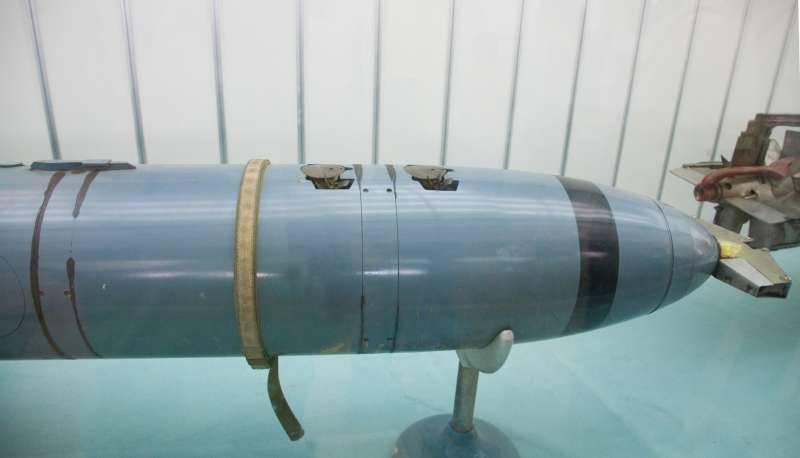
The head of the product Yu-2. In the slots on the top of the set fuses KAVT-55 with cocking impellers. Wikimedia Commons Photos
Torpedoes PAT-52 and PAT-52М were operated for 15-20 years and received good reviews from the military. However, over time, the use of such weapons has decreased. There were new torpedoes with higher performance, and in addition, the physical obsolescence of PAT-52 and the reduction in the number of such products in warehouses affected. As a result, the operation of the first jet torpedoes ceased no later than the seventies. In 1983, an order was issued to remove the PAT-52 and PAT-52М from the armament of the Soviet Navy, which officially fixed the actual rejection of such weapons.
After the development of Soviet naval aviation torpedoes RAT-52 went for export. The first foreign customer was China, who had not yet managed to spoil relations with the USSR. The carriers of this weapon were used purchased and self-built aircraft IL-28. The Chinese fleet mastered the Soviet torpedo and even used it in real combat clashes. At the end of the fifties, there were several battles in the Taiwan Strait, in which, among others, the naval aviation of the PRC, armed with torpedoes of Soviet manufacture, participated. By the mid-sixties, no longer able to buy ready-made weapons, China had mastered the production of a copy of PAT-52. Such a torpedo was named Yu-2. According to reports, this product is still in service and ready for use against ships and vessels of a potential enemy.
In the early sixties, Cuba expressed a desire to improve relations with the Soviet Union. Among other things, within the framework of such a friendship, military-technical cooperation was developed, which consisted in the supply of Soviet weapons and equipment. According to some reports, the PAT-52 jet torpedoes were supplied to Cuba along with other products. In addition, during the Caribbean crisis, several Soviet torpedo bombers were present on the island. Despite the complexity of the situation in the region, there was no evidence of real combat use of such weapons. Soviet torpedoes were used only for training purposes.
The theoretical work of the mid-forties led to the emergence of the original concept of aircraft weapons for attacking surface targets. In the future, the idea became the basis for a new project, which, in turn, led to the emergence and commissioning of a new torpedo. The product PAT-52 was the first domestic torpedo, originally developed for naval aviation and was not a remake of the existing weapons of ships or submarines. In addition, the most important innovation of the project was the first in domestic practice, the use of a jet engine as a power plant torpedoes.
Project A-2 / D-44 / PAT-52 allowed the naval aviation of the fleet to give high-performance weapons that could seriously affect the course of the naval battle. In addition, he contributed to the emergence of new technologies and verification of original ideas. The experience gained in the creation of the first jet torpedo was later used in the development of a new such weapon. Thus, the torpedo PAT-52 became an important element of the armament range of aviation of the USSR Navy, and also remained in national history as the first representative of a promising direction, which is still of great interest to the military.
Based on:
http://missiles.ru/
http://airwar.ru/
http://aviaros.narod.ru/
http://vpk-news.ru/
http://militaryrussia.ru/blog/topic-30.html
Shirokorad A.B. Weapons of the domestic fleet. 1945-2000. - Minsk: “Harvest”, 2001
Shirokorad A.B. The history of aviation weapons. Short essay. - Minsk: “Harvest”, 1999
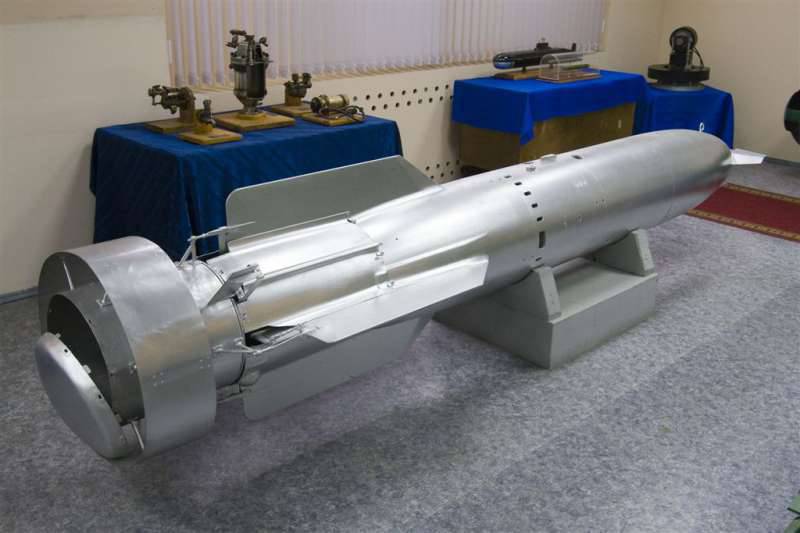
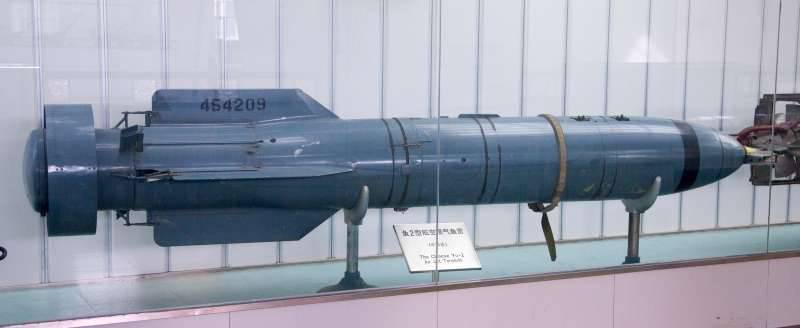
Information